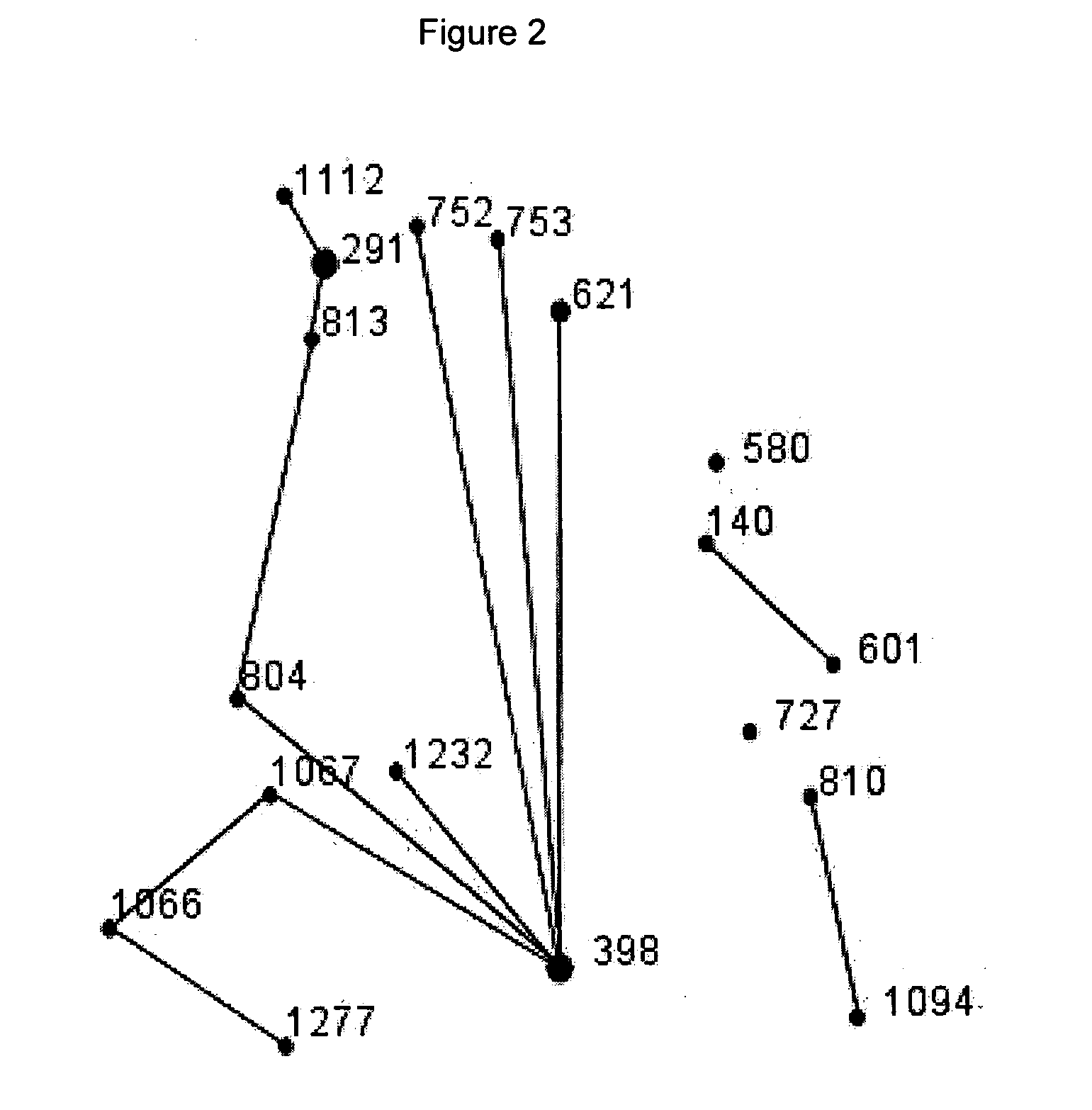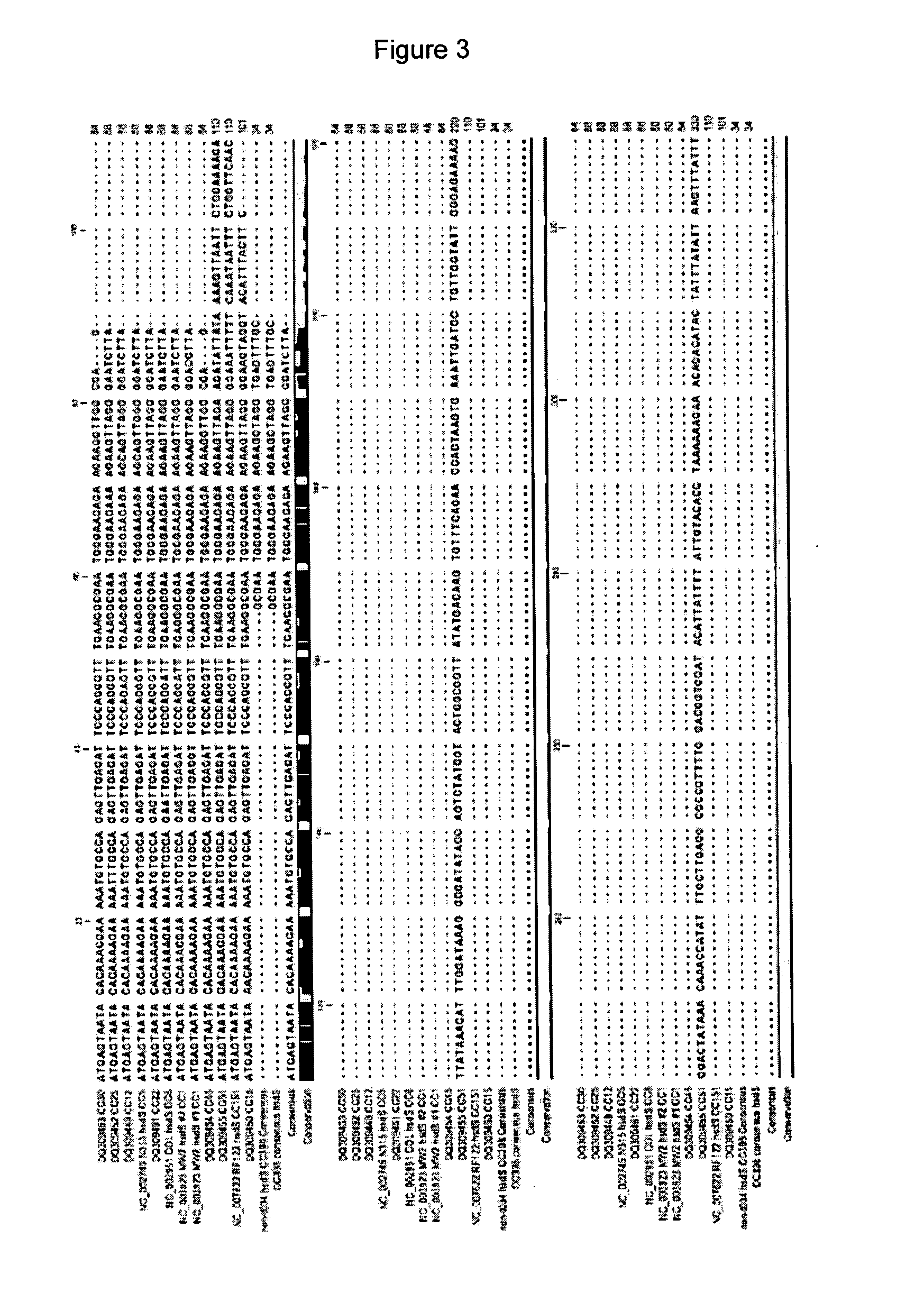DNA-based methods for clone-specific identification of staphylococcus aureus
a staphylococcus, clone-specific technology, applied in the field of dna-based methods for identification, detection and/or typing of staphylococcus aureus strains, clones and/or lineages, can solve the problems of major public health problems, major economic burden to society, and healthy carriage of these bacteria, and achieve rapid and reliable identification and high sequence variation
- Summary
- Abstract
- Description
- Claims
- Application Information
AI Technical Summary
Benefits of technology
Problems solved by technology
Method used
Image
Examples
example 1
Design of Primers Specific for the sau1hsdS1 Gene in S. aureus CC398
[0355]A 489-bp region within the sau1hsdS1 gene was tentatively amplified in 8 S. aureus strains belonging to CC398-related spa types using the non-specific primers AF (SEQ ID NO 6) and BF (SEQ ID NO 22) published by Cockfield et al. (2008). However, this experiment yielded negative results. The experiment was repeated using the forward primer AF (SEQ ID NO 6) and 4 novel reverse primers (SEQ ID NOs 2-5) targeting two conserved regions in the 5′-end of the gene. By this approach PCR products of approximately 475-bp were obtained from all strains. Alignment of the sequences from the 8 strains revealed that they were 100% identical (see FIG. 3), indicating that this region is highly conserved within CC398 (SEQ ID NO: 1). interestingly, the sau1hsdS1sequence in CC398 was distantly related (≦37% amino acid identity) to the sequence of the same gene in other S. aureus lineages. Four putative CC398-reverse primers (ST398 ...
example 2
Validation of the PCR Test for Identification of S. aureus CC398
[0356]The primers AF (SEQ ID NO 6) and ST398 r1 (SEQ ID NO 2) were tested on a large strain collection composed by 65 CC398 strains previously identified by MLST and / or spa typing and representative of 8 spa types, and by 211 non-CC398 strains of human and animal origin, including CC5, CC8, CC15, CC20, CC22, CC30, CC45, CC80 and CC152 (Table 1). All CC398 strains were positive (100% sensitivity) whereas all non-CC398 strains were negative (100% specificity).
TABLE 2List of strains used to validate the PCR testStrain codeHostspa repeat successionspa typeMLST / CCmecACC398 PCRDTU-70-95-9Swine08-16-02-25-02-25-24-25t2876CC398NegativePositiveA-7Swine08-16-02-25-02-25-34-24-24-25t1793CC398NegativePositiveA-6Swine08-16-02-25-02-25-34-24-24-25t1793CC398NegativePositiveA-17Swine08-16-02-25-02-25-34-24-24-25t1793CC398NegativePositiveA-3Swine08-16-02-25-02-25-34-24-24-25t1793CC398NegativePositiveA-2Swine08-16-02-25-02-25-34-24-24-25...
example 3
Development of the Multiplex PCR for Discrimination Between MRSA and MSSA CC398 Strains
[0357]In order to allow differentiation between MRSA and MSSA variants of CC398, the CC398-specific primer set AF (SEQ ID NO 6) ST398 r1 (SEQ ID NO 2) was combined with primers mecup1 (SEQ ID NO 7)-mecup2 (SE ID NO:8) targeting the methicillin resistance mecA gene. Such primers have been designed in a previous study to develop a diagnostic kit (EVIGENE MRSA) produced by Statens Serum Institut for rapid MRSA identification (Poulsen et al. 2003). The multiplex PCR was tested on 4 S. aureus strains representing MSSA non-CC398 (strain ATCC 6538), MRSA non-CC398 (strain ATCC 33591), MSSA CC398 (SSI 52615) and MRSA (KVL 288). The results of this experiment are shown in FIG. 1.
PUM
| Property | Measurement | Unit |
|---|---|---|
| Power | aaaaa | aaaaa |
| Power | aaaaa | aaaaa |
| Electrical resistance | aaaaa | aaaaa |
Abstract
Description
Claims
Application Information
 Login to View More
Login to View More - R&D
- Intellectual Property
- Life Sciences
- Materials
- Tech Scout
- Unparalleled Data Quality
- Higher Quality Content
- 60% Fewer Hallucinations
Browse by: Latest US Patents, China's latest patents, Technical Efficacy Thesaurus, Application Domain, Technology Topic, Popular Technical Reports.
© 2025 PatSnap. All rights reserved.Legal|Privacy policy|Modern Slavery Act Transparency Statement|Sitemap|About US| Contact US: help@patsnap.com



